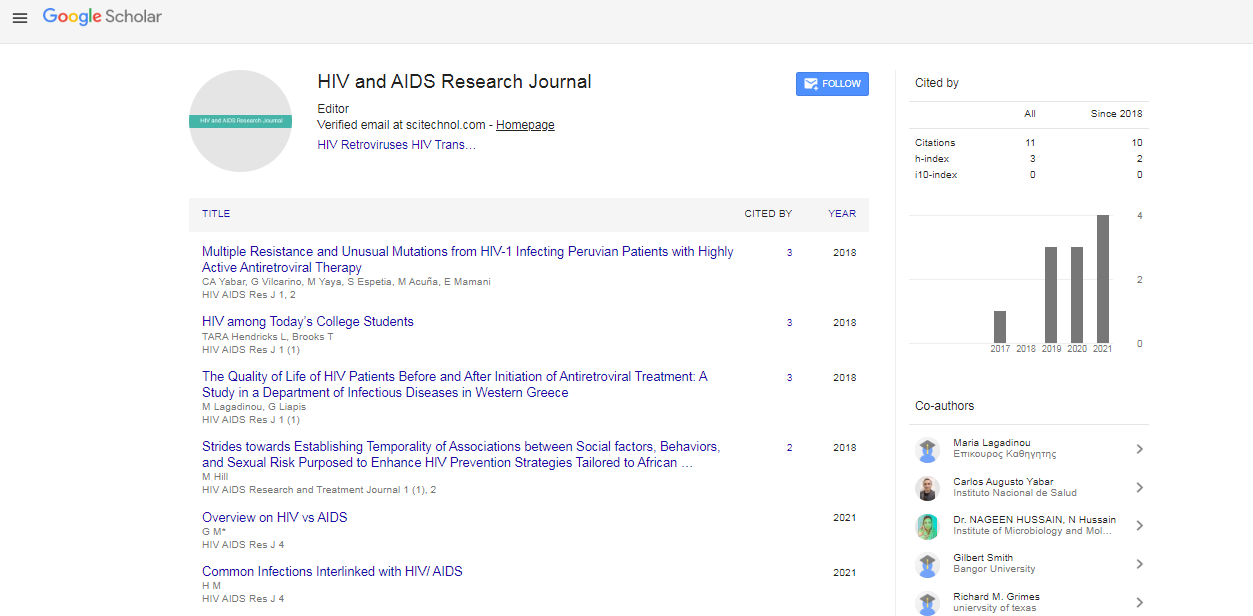Editorial, Hiv Aids Res Vol: 7 Issue: 1
Epidemiology of HIV and AIDS in India
Ritu Sharma*
Department of Community Medicine, Maulana Azad Medical College (MAMC), New Delhi, India
- *Corresponding Author:
- Ritu Sharma
Department of Community Medicine, Maulana Azad Medical College (MAMC), New Delhi, India
E-mail: ritu.sharma@mamc.edu.in
Received: 01-Mar-2025, Manuscript No. HARJ-25-170192; Editor assigned: 4-Mar-2025, Pre-QC No. HARJ-25-170192 (PQ); Reviewed: 20-Mar-2025, QC No HARJ-25-170192; Revised: 26-Mar- 2025, Manuscript No. HARJ-25-170192 (R); Published: 30-Mar-2025, DOI: 10.4172/Harj.1000
Citation: Ritu Sharma, Department of Community Medicine, Maulana Azad Medical College (MAMC), New Delhi, India. HIV AIDS Res J 7:1.
Copyright: © 2025 Ritu Sharma, this is an open-access article distributed under the terms of the Creative Commons Attribution License, which permits unrestricted use, distribution, and reproduction in any medium, provided the original author and source are credited.
INTRODUCTION
India has the third-largest population of people living with HIV (PLHIV), after South Africa and Nigeria. Despite this, India has made significant progress in reducing new infections by over 50% since 2000 through targeted prevention programs [1]. Understanding the epidemiological trends of HIV is critical for sustaining control and elimination efforts.
Current Scenario
According to the National AIDS Control Organisation (NACO), around 2.4 million PLHIV live in India, with adult prevalence at 0.22% [2]. The epidemic is concentrated among high-risk groupsâ??female sex workers, men who have sex with men, people who inject drugs, and transgender communities [3]. Certain states like Andhra Pradesh, Maharashtra, and Karnataka report higher prevalence due to sociocultural and economic factors.
Challenges
Late diagnosis, limited awareness, and stigma continue to affect early detection and treatment adherence. Migration, poverty, and limited access to health services in rural areas further contribute to regional disparities [4].
CONCLUSION
India has achieved notable success in controlling HIV but must strengthen surveillance, expand testing services, and reduce stigma to meet the global 95-95-95 targets.
REFERENCES
- UNAIDS. Global HIV & AIDS statistics. UNAIDS Report. 2022.
- NACO. Annual Report 2021-22. Ministry of Health and Family Welfare, Govt of India.
- Pandey A. HIV epidemic in India. Indian J Med Res. 2011;134: 749–760.
- Saggurti N. Migration and HIV risk in India. AIDS Behav. 2012;16: 1896–1906.
- Kumar R. Epidemiological trends of HIV in India. Indian J Public Health. 2019;63: 149–152.
 Spanish
Spanish  Chinese
Chinese  Russian
Russian  German
German  French
French  Japanese
Japanese  Portuguese
Portuguese  Hindi
Hindi 